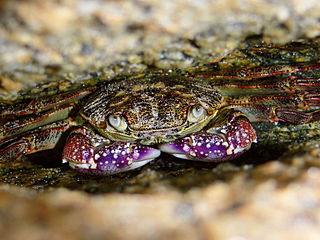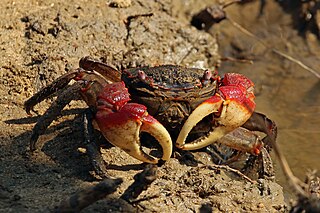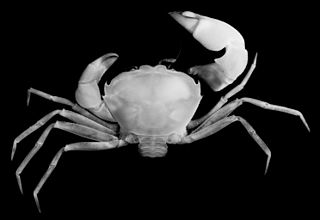
Eriocheir is a genus of crabs, including the Chinese mitten crab, E. sinensis. Formerly in the family Grapsidae, it is now placed in the Varunidae.

The tunnelling mud crab, Austrohelice crassa, is a marine large-eyed crab of the family Grapsidae, endemic to the sea coasts of New Zealand. Their carapace width is up to 40 mm.

Leptograpsus variegatus, known as the purple rock crab, is a marine large-eyed crab of the family Grapsidae, found in southern subtropical Indo-Pacific Oceans. It grows to around 50 millimetres (2.0 in) shell width. It is the only species in the genus Leptograpsus.

The red rock crab, Guinusia chabrus, is a marine large-eyed crab of the family Plagusiidae. It is found in the southern Indian and southern Pacific Oceans, including South Africa, Australia, New Zealand, and Chile.

Plagusia squamosa is a marine crab of the family Plagusiidae, formerly considered a subspecies of Plagusia depressa. It is found in tropical Indo-Pacific oceans. P. squamosa's carapace is bumpy and quite coarse, seemingly scaly, leading to its common name: The Scaly Rock Crab.

Cancridae is a family of crabs. It comprises six extant genera, and ten exclusively fossil genera, in two subfamilies:

The Sesarmidae are a family of crabs, previously included in the Grapsidae by many authors. Several species, namely in Geosesarma, Metopaulias, and Sesarma, are true terrestrial crabs. They do not need to return to the sea even for breeding.

The Varunidae are a family of thoracotrematan crabs. The delimitation of this family, part of the taxonomically confusing Grapsoidea, is undergoing revision. For a long time, they were placed at the rank of subfamily in the Grapsidae, but they appear to be closest to Macropthalmus and the Mictyridae, which are usually placed in the Ocypodoidea. It may thus be better to merge the latter superfamily with the Grapsoidea, retaining the latter name as it is older.

Percnon gibbesi is a species of crab. It is one of at least two species commonly called "Sally Lightfoot", and is also referred to as the nimble spray crab or urchin crab. It has been described as "the most invasive decapod species to enter the Mediterranean".

Percnon is a genus of crabs. It is "doubtfully placed" in the family Plagusiidae, and it has also been included in the family Grapsidae.

Matutidae is a family of crabs, sometimes called moon crabs, adapted for swimming or digging. They differ from the swimming crabs of the family Portunidae in that all five pairs of legs are flattened, rather than just the last pair, as in Portunidae. Crabs in the Matutidae are aggressive predators.

Pseudozioidea is a superfamily of crabs, formerly treated in the Eriphioidea, Carpilioidea, Xanthoidea, Pilumnoidea and Goneplacoidea. A number of fossils from the Eocene onwards are known from the family Pseudoziidae. Eleven genera are recognised in three families:

Palicoidea is a superfamily of crabs, comprising the two families Crossotonotidae and Palicidae. Together, they contain 13 genera, including two genera in the Palicidae known only from fossils. The two families were previously treated as two subfamilies in a Palicidae of wider circumscription.

Planes is a genus of crabs in the family Grapsidae that currently comprises three extant species: Planes minutus, Planes marinus Rathbun, 1914, and Planes major (=cyaneus). A further fossil species is known from the Middle Miocene of the Caucasus.

Epialtidae is a family of crabs, containing the subfamilies:

Xantho is a genus of crabs in the family Xanthidae, containing five extant species, all restricted to the north-east Atlantic Ocean and Mediterranean Sea, although Xantho granulicarpis is not universally recognised as a separate species from Xantho hydrophilus:

Geograpsus is a genus of crabs in the family Grapsidae, containing four extant species, and one extinct species:
Polydectus cupulifer is a species of crab in the family Xanthidae, and the only species in the genus Polydectus. Together with the genus Lybia, it forms the subfamily Polydectinae. It is found in the Indo-Pacific, ranging from Madagascar and the Red Sea in the west to Japan, Hawaii and French Polynesia in the east. P. cupulifer is densely covered with setae (bristles), and frequently carries a sea anemone in each chela (claw).

The Panopeidae are a family containing 26 genera of morphologically similar crabs, often known as "mud crabs". Their centers of diversity are the Atlantic Ocean and eastern Pacific Ocean.

















